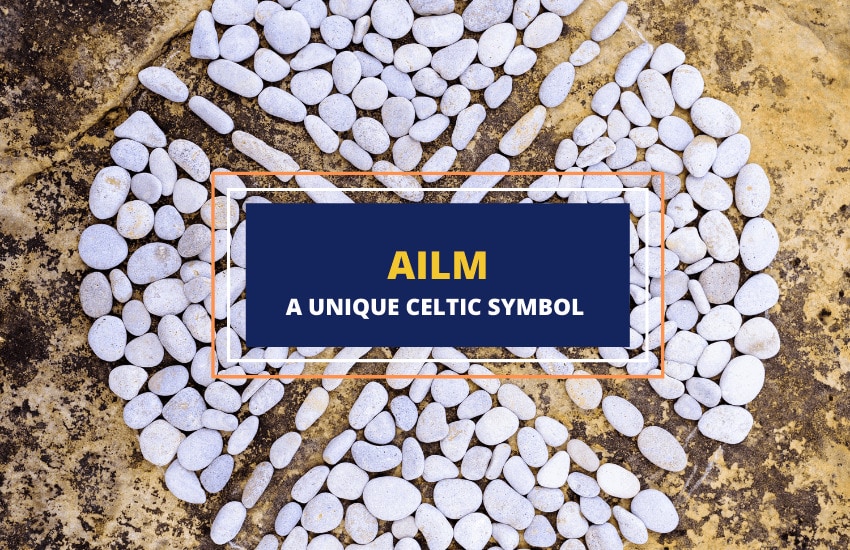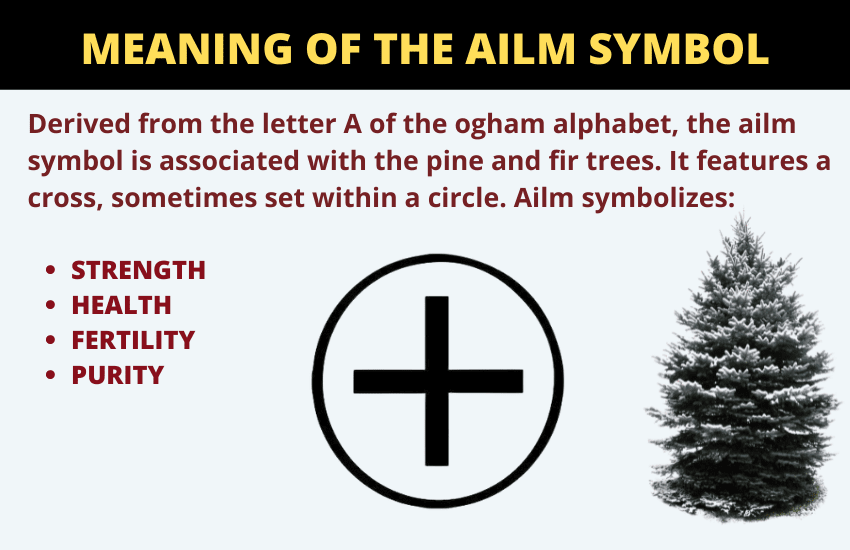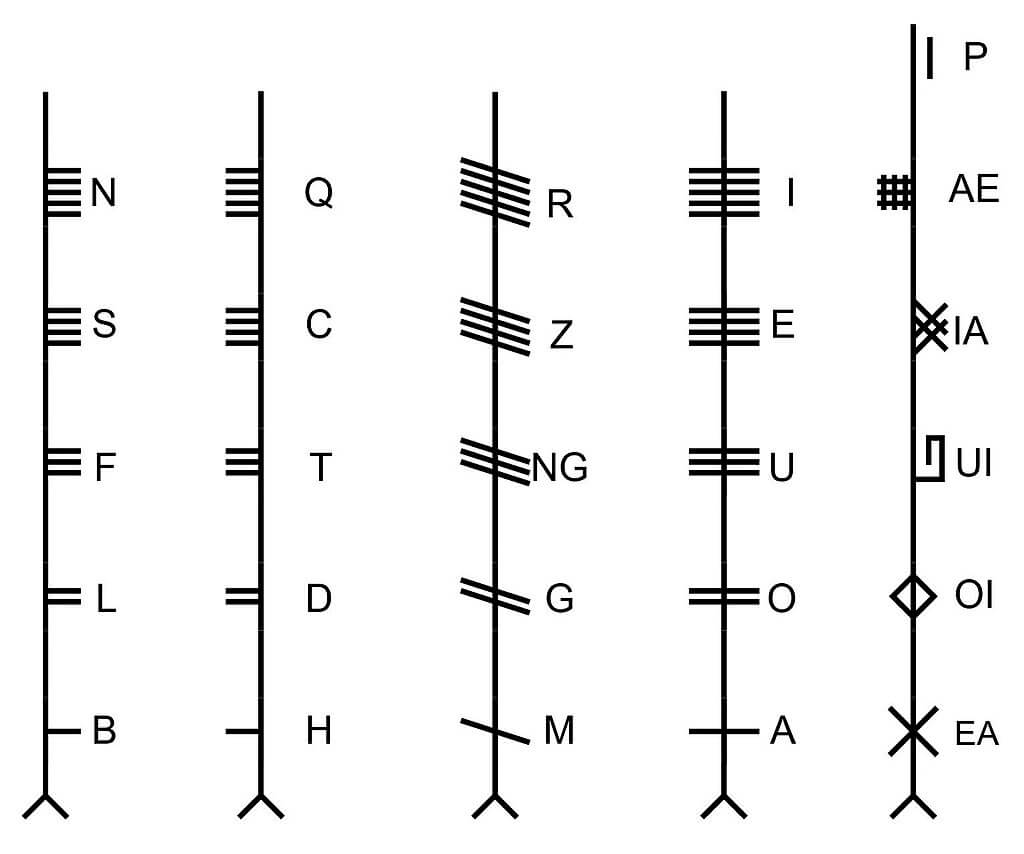
Table of Contents
As a symbol of strength, the ailm had great significance in the lives of the ancient Celts. Although simple in its appearance, featuring an equal-armed cross set within a circle, the ailm is deeply meaningful. Here’s what to know about the meaning and significance of the symbol.
What Is Ailm?

The Celts used the Ogham alphabet, sometimes called the Gaelic Tree Alphabet, where each letter was assigned the name of a tree or plant. The ailm corresponded to the pine and fir tree, though some sources link it to elm tree.
The sound of each letter is the same as the initial sound of the Irish name of its corresponding tree. The first vowel sound and 16th character in the alphabet, the ailm has the phonetic value of A.
The ailm symbol takes the primitive form of a basic cross shape or a plus sign, but sometimes depicted within a circle. The symbol has a mystical meaning and is often used for divination.
Meaning and Symbolism of Ailm

The ailm symbol is used in a variety of contexts, and its interpretation is often associated with the tree it represents, the pine or fir tree. The vowel sound itself can be expressed in different ways— such as pain, wonder, and revelation—giving it different meanings. Here are some of its meanings:
1. A Symbol of Strength and resilience
The ailm symbol is associated with resilience and endurance, and often used to represent inner strength. Its symbolism is likely derived from the significance of pine and fir trees, which can withstand adverse conditions. In a symbolic sense, the ailm serves as inspiration to rise above adversity.
2. Clear Vision and High Views
As silver fir trees often grow at high altitudes, standing above other trees, the Ailm symbol comes to represent clear vision and high views, suggesting perspective and foresight.
3. Connection to the Divine
The height and perpetual greenness of the silver fir tree are seen as linking to the divine, making Ailm a symbol of spiritual insight and divine proximity.
4. Health and Healing
As a representation of elm trees, the ailm symbol is also associated with regeneration, as the tree can regrow from new shoots sent out from the roots. The pine and fir trees are also associated with regeneration and resurrection.
A superstition exists that pinecones and branches must be hung over the bed to ward off illness. By hanging them in one’s home, they’re believed to bring strength and vitality. In aromatherapy, pine is often used for clearing toxins from the body. These associations link to the ailm symbol.
5. Symbol of Fertility
The ailm symbolism of fertility is likely derived from the magical use of pinecones as fertility charms, especially for men. There was a tradition of placing pinecones together with acorns on the mythical Maenad’s wand, in order to draw water or wine from the earth. In some beliefs, pinecones and acorns are regarded as a sacred sexual union.
6. A Symbol of Purity
When depicted in a circle, the ailm represents the wholeness or purity of the soul. Pinecones were seen as powerful herbs for purification rites, so the ailm symbol is also believed to bring clear vision and decongest the mind, body and spirit.
7. Eternal Life
The evergreen nature of the silver fir tree, which stays green throughout the year, symbolizes immortality and eternal life. This association highlights the cycle of life and nature’s continuity.
With What Tree Was the Ailm Associated?
There’s a lot of confusion regarding which tree should be assigned to the ailm. In the early Irish Brehon laws, the pine was called ochtach, not ailm. In Celtic lore, ailm is thought to mean pine tree, which was one of the seven noble trees. The pine tree is native to the British Isles and had a special meaning for the Scottish. It was thought to be a good place to bury warriors, heroes, and chieftains.
In the 14th-century Book of Ballymote, on the ogham tract, the ailm is referred to as the fir tree. However, the fir tree isn’t native to the British Isles, and was only introduced to Scotland by 1603. The Irish term for the fir tree is giuis. Before the 18th century, the Scots pine was known as the Scots fir, suggesting that the term fir in the ogham tract is a reference to the pine.
Modern interpretation of the ailm symbol associates it with the silver fir, which is the tallest European native tree. In European usage, the pine tree and the fir tree are used interchangeably, since the two have similar appearance and qualities. It’s said that felling the pine tree unlawfully incurred a death penalty, which was also the same punishment for felling the hazel tree, apple tree, and entire groves of any tree.
In some regions, the ailm is associated with the elm tree, particularly with the Cornish elm that grows in Cornwall, Devon, and southwestern Ireland. In Welsh Celtic tradition, the trees associated with ailm are connected to the Gwynfyd, the realm where heroes, spirits and deities exist. In Yakut mythology, the souls of shamans are even believed to have been born in fir trees.
The Ailm Symbol and Ogham in Celtic History

Some historians believe that the earliest dateable ogham inscription can be traced back to the 2nd century CE. These inscriptions were found on rock faces, stones, crosses, and manuscripts. Most inscriptions have been found on memorials, with the function of memorial writing, but it’s believed to have magical elements.
When the Roman alphabet and the runes were introduced to Ireland, they took the function of memorial writing, but the use of Ogham became restricted to the secret and magical realms. In the 7th-century CE Auraicept na n-Éces, also known as The Scholars’Primer, the ogham is described as a tree to be climbed, since it’s marked vertically upwards along a central stem.
The ogham letters and their associated trees and plants were recorded in various manuscripts. Ailm is thought to be the Old Irish word for fir or pine tree. In the manuscripts, each letter was associated with kennings, short cryptic phrases that are difficult to understand. Some of these kennings are symbolic, while others are descriptive, giving practical information.
For the ailm, its kennings were the beginning of an answer, the beginning of calling, or the loudest groan. In divination, it’s believed to mean calling out or responding, as well as indicating the start of life experiences or a new cycle. In cultural context, the vowel sound ah that begins the word ailm was associated with the first utterance of an infant at his birth.
The ogham alphabet was also used by the filid, the shaman poets in ancient Ireland whose roles were to preserve the Celtic oral tradition, as well as some tales and genealogies. The ailm symbol also gained a wide range of possible divinatory meanings, which are often derived from other cultural systems like occultism.
In divination, the trees associated with the ailm—the pine and fir trees—are symbols of perspective and used by shamans in envisioning the upper realms. They’re sometimes used as a charm for overturning bad luck and restoring hope and positivity. In an esoteric belief, the ailm is associated with the key to transforming ignorance and inexperience into clarity and wisdom.
In Brief
One of the most recognizable Celtic symbols, the ailm is a basic cross shape or plus sign, sometimes depicted in a circle. From a culture where symbols were keys to the mystical and spiritual realms, the ailm is thought to have magical meanings. Derived from the letter A of the Ogham alphabet, it’s associated with the pine and fir trees, and symbolizes strength, healing, fertility, and purity.








